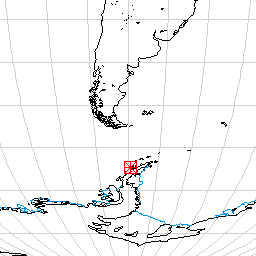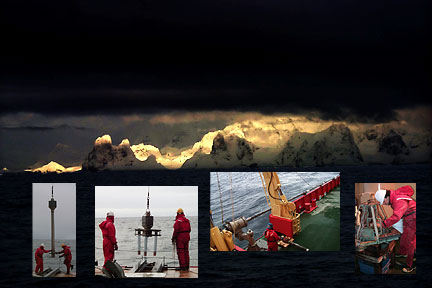 |
|
|
 |
| This is of a view from the ship while on station in the Palmer Deep. Not too bad a place to go to work. The mountains are up to 5000 foot peaks on Anvers Island. The photos are from left to right a Kasten core, a multi core, the jumbo piston core, which extends down the deck railing 50 feet, and Dr. Patrick Reynolds checking a biologic grab sampler. This is all work that went on today. The jumbo piston core was used for the first time today and we collected a fifty foot core of sediment. |
 |
Greetings,
The easter bunny visited the ship leaving easter eggs throughout the labs, dinning hall, lounge and computer room. Pretty tough easter bunny though. A note on the main board said that there was one egg a piece and if you took more than one egg, the easter bunny would throw you overboard.
We are continuing our work in the Palmer Deep. Today was spent coreing at sites choosen using the data collected with the multibeam profiler yesterday.
We first collected a Kasten core, 10 feet of laminated mud, which was sampled for bulk density, radio carbon age dating, pore water chemistry, magnetics and diatoms. We then used the multi corer a set of 3, 4 foot tubes arranged in a triangular pattern to collect samples at the water/sediment interface. The Kasten core impacts the bottom so hard that this very loose/fine material is usually blown away by the shockwave of the approaching corer. The multi corer is much lighter and is allowed to stabilize about 3-5 meters above the bottom and then is slowly lowered in.
The three tube arrangement allows for 3 chances to get the interface and we got it in two of the three tubes on this attempt. After the multicorer, it was time for the JUMBO piston core. This thing is a monster that can take a core from fifty to ninety feet long. The corer is so big that it is assembled along the deck wall and the weight, 1700 pounds, sits in a special cradle that pivots allowing the core tube to hang down into the water. The ships crane then lifts the weight from the cradle and begins lowering the corer. Pulling the core out of the bottom really runs up the numbers on the winch rooms tension meter and actually causes the ship to list.
At this station we sent down a 50 foot jumbo piston core and actually burried the weight in the mud on the bottom, indicating that the sediments are over 50 feet deep in this area. At one of our later stations we will use the JPC with 90 feet of core tubing.
OK, I know your all wondering how the sediment stays in the tube. All the corers work basicaly the same way. Inside cutter nose which is the first thing to enter the sediment is a core catcher. This looks like a circle of metal fingers pointing up towards the top of the corer. The sediment is forced up the tube as the tube buries itself in the bottom. As the sediment comes in the core catcher fingers spread letting the sediment through. When the core is pulled out the fingers keep the sediment in the tube. They are stiff enough to not to be inverted by the weight of the sediment in the core tube. These sediments are stiff, about the consistancy of bread or cookie dough, greeninsh brown in color and occasionally have a few worms in them.
Tonight, Dr. Patrick Reynolds is collecting biological samples with a grab sampler. This device is like an inverted bear trap. Instead of flat jaws it has what looks like a bowl cut into two halves. These scoops are pulled open with strong spings that are clipped to two triggering arms.
The triggering arms have flat pads that hit the bottom and relese the spings closing the scoops collecting the top 20 cms or so of the ocean floor. The current grab is at a depth of 1366 meters below sea level. The winch lets the sampler down at around 45 meter/minute and brings it up around 30 meters per minute. (Around 30 minutes down and 45 minutes up.) An hour and fifteen minutes round trip and so far one good closure and two failed attempts. Calls for lots of patience on the part of the winch operators, marine science techs and Dr. Reynolds.
As it got dark tonight we were treated to a rare sight. From the stern of the ship you could see one lone light shining on shore. This is Palmer Station. It seems really strange being out here, not having seen anyone since we left Punta Arenas, and there in the darkness, is a lone light shining out to sea.
Best wishes to everyone,
Cheers,
Dave Tewksbury
|
|
 |